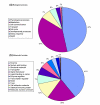A comprehensive transcript index of the human genome generated using microarrays and computational approaches
- PMID: 15461792
- PMCID: PMC545593
- DOI: 10.1186/gb-2004-5-10-r73
A comprehensive transcript index of the human genome generated using microarrays and computational approaches
Abstract
Background: Computational and microarray-based experimental approaches were used to generate a comprehensive transcript index for the human genome. Oligonucleotide probes designed from approximately 50,000 known and predicted transcript sequences from the human genome were used to survey transcription from a diverse set of 60 tissues and cell lines using ink-jet microarrays. Further, expression activity over at least six conditions was more generally assessed using genomic tiling arrays consisting of probes tiled through a repeat-masked version of the genomic sequence making up chromosomes 20 and 22.
Results: The combination of microarray data with extensive genome annotations resulted in a set of 28,456 experimentally supported transcripts. This set of high-confidence transcripts represents the first experimentally driven annotation of the human genome. In addition, the results from genomic tiling suggest that a large amount of transcription exists outside of annotated regions of the genome and serves as an example of how this activity could be measured on a genome-wide scale.
Conclusions: These data represent one of the most comprehensive assessments of transcriptional activity in the human genome and provide an atlas of human gene expression over a unique set of gene predictions. Before the annotation of the human genome is considered complete, however, the previously unannotated transcriptional activity throughout the genome must be fully characterized.
Figures




References
-
- Adams MD, Kerlavage AR, Fleischmann RD, Fuldner RA, Bult CJ, Lee NH, EF Kitrkness, Weinstock KG, Gocayne JD, White O, et al. Initial assessment of human gene diversity and expression patterns based upon 83 million nucleotides of cDNA sequence. Nature. 1995;377:3–174. - PubMed
MeSH terms
LinkOut - more resources
Full Text Sources
Other Literature Sources
Molecular Biology Databases

